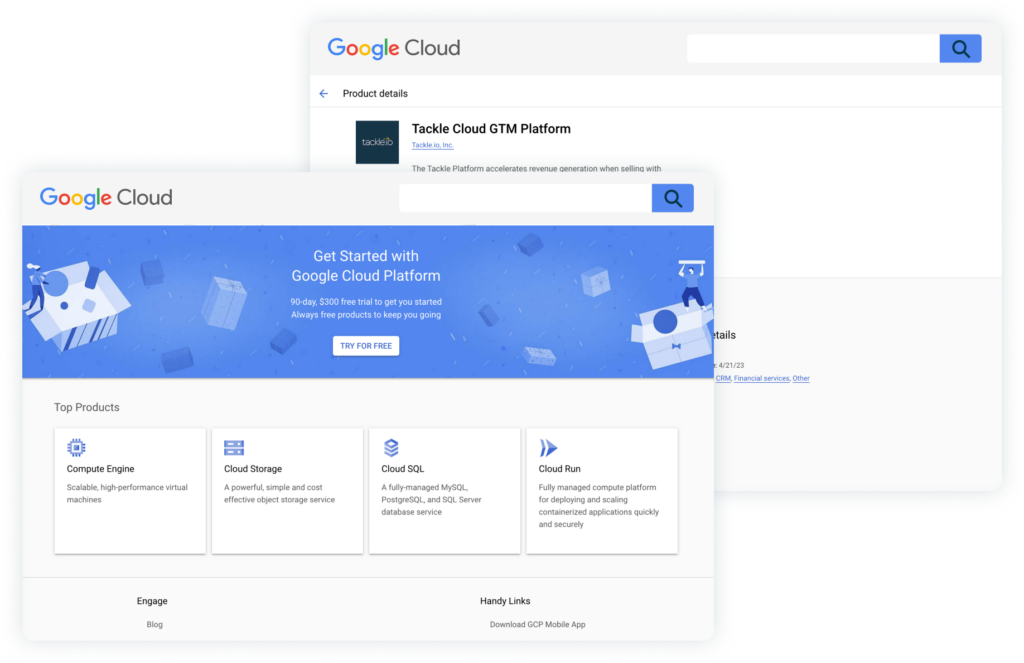Cloud marketplaces are changing the game for B2B software sales for ISVs, as they offer a faster way to reach customers, speed up procurement, and accelerate revenue—all without the friction of a traditional sales cycle. But if you’re just getting started with Google Cloud Marketplace, it can often feel a bit overwhelming.
That’s precisely what this guide is for. It’s your one-stop-shop to understand how Google Cloud Marketplace works, what programs are available, and how to make the most of this channel as part of your overall Cloud GTM strategy.
Read More: 3 Reasons Buyers Are Flocking to Cloud Marketplaces
Now let’s get started with the basics.
What is GCP Marketplace?
Think of the Google Cloud Marketplace as a curated catalog of software solutions that’s built to run on Google Cloud. It gives buyers an easy way to find, research, and buy solutions—all while sticking with a vendor they already trust: Google.
For buyers, it streamlines procurements. In many cases, they can skip long internal approval processes if Google Cloud is already an approved vendor. That means faster decisions and quicker deals.
For sellers? It’s a direct line to a massive global audience, all with cloud budgets that companies are ready to spend.
What are the Benefits of GCP Marketplace?
Selling through Google Cloud Marketplace comes with many benefits, especially for ISVs looking to scale. Some of these include:
- Faster sales cycles: Your software gets integrated with Google Cloud billing, so procurement is faster and more repeatable.
- Expanded reach: Get access to buyers with committed Google Cloud spend who are actively looking for new solutions.
- Built in trust: Leverage the Google Cloud brand to boost your credibility and visibility with customers.
- Co-selling opportunities: Tap into Google’s co-sell teams to enhance your prospecting and boost your sales efforts.
- Customer incentives: Buyers can use your product purchase to burn down their Google Cloud committed spend—making your solution even more attractive.
What are the Key Google Cloud Marketplace Programs?
If you’re thinking about listing on Google Cloud Marketplace, your first step is to join the Google Cloud Partner Advantage Program, as it’s mandatory to join in order to list. This program is your gateway to all things marketplace and unlocks the resources and support you’ll need to succeed on cloud.
Partner Advantage is the central hub for all Google Cloud partner resources and gives you access to best practices, documentation, co-selling and co-marketing resources, and technical support from Google Cloud experts.
Partner Advantage has three engagement models depending on how you work with Google Cloud:
- Self Engagement Model: Companies that integrate Google Cloud offerings into their portfolio and sell Google Cloud technologies to their customer base and indirect resellers.
- Service Engagement Model: Companies that provide consulting and integration services, transform and manage customer apps and workloads, or provide Google Cloud authorized training.
- Build Engagement Model: Companies that create solutions that integrate with or run on Google Cloud to complement or enhance Google’s products.
If you’re an ISV listing on Google Cloud Marketplace, you’ll want to join under the “Build” engagement model (though you have the option to join under more than one).

Extra Google Cloud Resources for ISVs
Google doesn’t stop at marketplace access—they’ve built out additional programs and resources to help ISVs build, list, and grow, such as:
- Google Cloud ISV/SaaS Center of Excellence (CoE): A dedicated resource center with expert ISV Solution Architects who can help you with technical guidance, app deployment strategies, and best practices for cloud success.
- Google Cloud Skills Boost: Need help integrating Google Cloud APIs? This training hub can get your team up to speed fast.
- Partner Marketing Studio: A suite of turnkey marketing tools and templates to help you launch campaigns and generate demand.
How to Get Listed on GCP Marketplace
On Google Cloud Marketplace, you can offer production-ready stacks, products, and datasets to accelerate deployment, so customers spend less time installing your software.
Ready to go live? Here’s what the listing process on Google Cloud Marketplace typically looks like:
- Have a viable product that successfully runs on Google Cloud.
- Create a Google Cloud partner account.
- Join the Partner Advantage Program.
- Apply to become a GCP Marketplace partner.
- Prep your product for deployment on GCP Marketplace and build deployment packages.
- Create a marketplace listing.
- Submit for Google’s review and approval.
Once you’re listed, your product will be available to buyers as a line item on their Google Cloud bill—with support for subscription, pay-as-you-go, or custom pricing models. It’s a seamless experience for your customers and a big win for your sales team.
Does GCP Marketplace Charge a Fee?
Yes, like most marketplaces, there’s a small cost to sell through their platform. Google Cloud Marketplace takes a standard revenue share fee of 3% on all transactions. The remaining 97% goes to you, the seller, based on Google’s payment schedule.
Co-selling with Google Cloud
Co-selling is a collaborative partnership between the ISV and Google Cloud to help promote Google Cloud’s services and accelerate sales within Google Cloud Marketplace. In a co-selling relationship, Google Cloud’s sales team and the ISV will collaborate to help buyers evaluate and purchase the software they need. The goal is to help the ISV close more deals faster while helping Google to expand its own business and boost cloud consumption.
A few things to know:
-
- Start with Partner Advantage. This is your entry point to co-sell support (it’s like the Google equivalent of AWS’s ACE program).
- Identify opportunities. The first step to co-selling with Google Cloud is for the ISV to identify upcoming opportunities or renewals that could potentially transact through the marketplace.
- Work with a rep. If you’ve got a Field Service Rep (or ISV Specialist, if you’ve been assigned one), loop them in early. They can help guide your co-sell journey.
- Share success. Every time you close a deal through Google Cloud Marketplace, keep Google in the loop. These wins build trust—and momentum.
Pro tip: Entering into a co-selling partnership with Google Cloud Marketplace hinges on establishing a solid “better together” story. A “better together” story is simply messaging that illustrates how your solution and Google Cloud complement each other.
Read More: Co-selling 101 for Startups: Stand Out in a Crowded Field
Building Success with Google Cloud Marketplace
The Google Cloud Marketplace is more than a place to list your product—it’s a launch pad for growth and can be a highly effective channel for scaling your your marketplace strategy. Google continues to invest in its marketplace, and partners who lean into that investment tend to see real results.
That said, success doesn’t happen by accident. It takes thoughtful planning, the right partner programs, and, often, some technical know-how to get listed and start scaling.
Whether you’re exploring marketplace for the first time or looking to optimize your listing, Tackle is here to help. Schedule a demo today to see how Tackle can help you go to market faster on Google Cloud!
Frequently-Asked Questions (FAQs)
Who sells on Google Cloud Marketplace?
You’ll find a mix of independent software vendors (ISVs), data providers, and consulting partners selling everything from SaaS products to professional services. Google Cloud’s global reach helps these companies connect with more customers, more quickly.
What type of products are sold on Google Cloud Marketplace?
Google Cloud Marketplace features a variety of third-party software, data, and services. Popular categories include DevOps, security, networking, business applications, machine learning, operating systems, professional services, and data products. Products are available across various pricing models and deployment methods to fit how buyers want to consume.
How does Google Cloud Marketplace handle payments to ISVs?
Each month, Google computes how much customers paid for an ISV’s products, and what Google owes to the ISV (including amounts for metered listings). ISVs receive payouts typically on the 21st of every month. Google pays ISVs the aggregated amount due from all customers for the month.
Who shops on Google Cloud Marketplace?
Google Cloud Marketplace attracts a wide range of B2B software buyers—from small companies to large enterprises—looking to solve business problems. If they use Google Cloud and need software or services that run on it, marketplace makes it easy for them to discover, evaluate, and buy, often by using pre-approved cloud spend.


